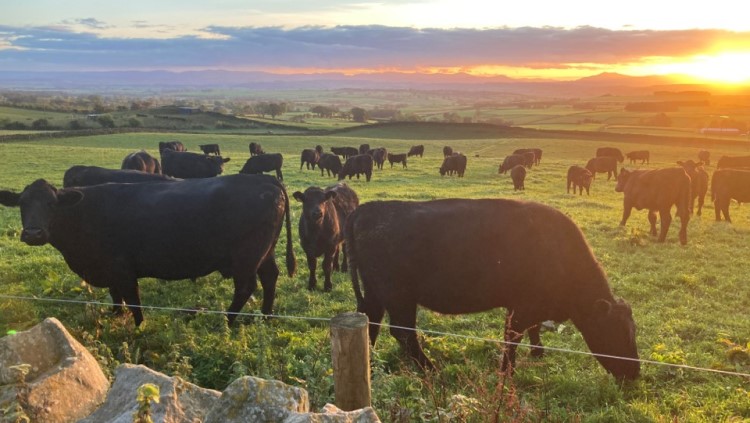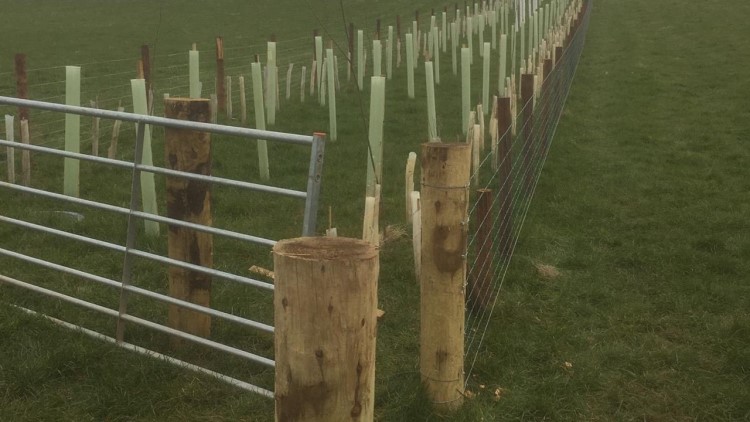- Home
- Knowledge library
- Agroforestry experiences: Cannerheugh Farm, a rotational grazing system in Cumbria
Agroforestry experiences: Cannerheugh Farm, a rotational grazing system in Cumbria
Find out how a farm in Cumbria is integrating agroforestry in a rotational grazing system. Learn about the tree and hedging species used, the planting approach, and the financial and other benefits.
About Cannerheugh Farm
Nic (Nicola) and Paul Renison moved to Cannerheugh Farm with their two daughters in 2012. The traditional livestock farm is in Cumbria, on the edge of the Pennines.
Following a visit to an organic farming system in Northumberland, and due to increasing pressures to reduce input costs, they moved towards a more regenerative way of farming.
Sitting on 141 hectares of sandy, loamy soil, the farm has 80 suckler cows, 600 chickens (with a mobile laying unit) and a few outdoor pigs.
Nic and Paul aim to produce meat in a productive and sustainable way by using a rotational grazing system.
Nic and Paul’s agroforestry journey

Nic and Paul started to create a wood pasture system in 2014. They took inspiration from a visit to Andrew Barber in Scotland and from other farms.
The planting was designed to fit in with the established rotational grazing system, based on the land’s flow and topography. Initially, hedges were planted into hedge banks, but they are now planted straight into the field. The farm’s trees and hedges are now integral to the grazing system.
They also provide shelter and protection for livestock and soil. They counter the effect of the Helm Wind, a strong north-easterly wind that blows down from the Pennines. The resource also provides shade during increasingly hotter summer spells.
The Renisons focused on building stocks of hedgerows and trees in the larger, sparser fields. They planted most of the trees and hedges themselves, with some help from contractors and volunteers. This approach allowed them to care for the plants from the start, just like they care for their youngstock. Nic said:
“The trees and hedges can be compared with a heifer calf: not much happens for a few years, then it blossoms, getting better and better each year.”
Initial establishment was good (90%). This was attributed to good early planting and watering (when required). The Renisons to clear grass and weeds from the tree bases.
Pete Leeson of the Woodland Trust provided advice on hedge and tree selection. Native species were planted, including oak, hawthorn, crab apple, willow, hazel and dog rose. A Higher-Level Stewardship (HLS) agreement and Farming in Protected Landscapes (FiPL) grants paid for the hedges and trees.
Some of the wood pasture is in areas that receive funding via the Countryside Stewardship scheme. The Renisons hope to apply for agroforestry grants in the recently expanded Sustainable Farming Incentive (SFI) offer.
Future opportunities
Although the agroforestry activity means that parts of the field are taken out of crop and pasture production, the hedges and trees are improving insect and bird diversity, as well as increasing job satisfaction for staff.
Importantly, agroforestry is making the farm more profitable. The hedges could provide a woodchip source for animal bedding, which would reduce the need to buy straw.
The inclusion of fruit trees will in time provide a point of interest for farm visits and become a source of food for the family, though there are no plans to sell fruit off the farm.
Nic and Paul’s agroforestry tips
- Peer-to-peer learning is great for seeing other agroforestry systems in practice
- Explore funding sources (see funding opportunities on the Getting started in agroforestry webpage)
- Order trees by late spring/early summer if planting in the autumn (nurseries are often short of trees)
- Think about the biosecurity of the trees you intend to purchase
- Consider the advantages of planting willow (research suggests it has many benefits)
- Use oak with caution if you are grazing cows, as high acorn consumption can be damaging to their health
- Use a mix of species for hedges for maximum levels of biodiversity
- Get the trees in the ground promptly after delivery (heel them in if you are waiting for labour to finish the job)
- When planting whips, keep their storage bags wet
- Take before-and-after photos of your agroforestry project
- Don’t get bamboozled by tree options and agroforestry design, it is like putting in new hedges
- If you make a mistake, it is not the end of the world


